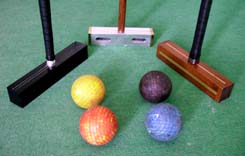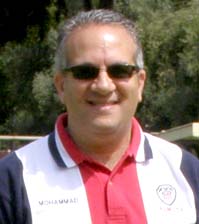

|
Back to |
| The Front Page |
| News & Features |

|
Will Egyptian balls conquer the sport? |
|
by Bob Alman, with Mohammad Kamal and David Bent venue pictures by Lila Photos; ball photos by David Bent Posted December 31, 2010
|
In Egypt in the 70's, the Egyptian Croquet Federation grew swiftly in tandem with the development of the Golf Croquet as the national game. Hard hitting, bigger back swings, and a fast stroke with a wrist hinge propelled the balls at more than 40 mph. Balls of standard manufacture chipped and broke, and replacing them was a huge expense for Egyptian clubs in the post-colonial period when hard currency was needed to maintain operations at domestic factories. An inexpensive ball that was also durable was needed, and that's what they developed. It is reported that the Egyptian-made ball they came up with has never been chipped or broken - not once in 40 years! The Egyptians, 15 years after they joined the World Croquet Federation, are still undefeated as Golf Croquet world champions. Now, players from many lands are touting not just Golf Croquet but also the Egyptian ball, for the unique values they both bring to the sport.
The fourth invitational sponsored by the International Polo Club Palm Beach has the highest announced purse of any 2011 event in the croquet world - $8,000, $5,000 of which goes to the winner. But its main distinction may be as the first event outside Egypt to use balls of Egyptian manufacture in major competition. The players themselves suggested using these balls. Although the organizers were at first inclined to say, "This is America, so we'll use an American ball," the principle host and developer of the tournament, Don Jacobson, was open-minded and suggested trying the balls out first on the IPC croquet court.

|
| The stars of the 2011 International Polo Club Palm Beach Golf Croquet Invitational, debuting in major international competition, are not especially pretty, but their hidden qualities are making them increasingly popular for tournament play. |
| THE PLAYERS, FEBRUARY 2011 |
|
Egypt - Khaled Younis, Ahmed Nasr
See detailed player profiles on the Bulletin Board
|
Jacobson - the final arbiter on all the decisions about his tournament - agreed to keep his mind open, but only after we did our homework. We soon found out that only two of the eight top-level players in the event had never used them before; David Bent was one of them. All the players were forewarned by email of the possibility; none of them urged us not to do it, and several applauded the decision. We found out that there is a small and growing movement among prominent non-Egyptian players to spread the use of these balls internationally.
After consulting with many people who ought to know - many represented in this article - Jacobson gave his approval. We were all in agreement; these balls would be bring an additional distinction in an already prestigious tournament.
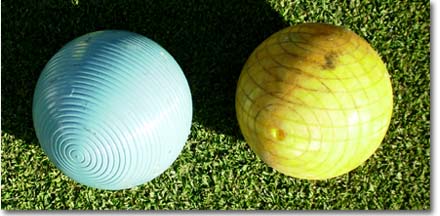
|
| The Egyptian ball on the right is slightly smaller, slightly heavier, much harder than the conventional plastic croquet ball, and reported to be virtually unbreakable. |
But the makers of Sunshiny and Dawson balls needn't be worried: the Egyptian balls will surely not be used for any form of the game that employs two-ball (croquet) shots. The more likely development internationally as non-Egyptians continue to try to knock off the Egyptian masters of the game is likely to be two different sets of equipment for two different games: the balls and mallets currently in use for Association play; and balls and mallets engineered or chosen specifically for Golf Croquet at the most competitive levels.
What the players say
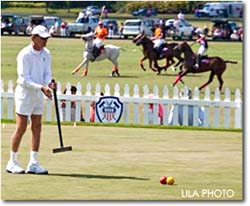
|
| During the croquet finals match in 2010 (played by Association laws) shouting players on polo horses rushed past the croquet lawn at frequent intervals, separated only by the court's higher elevation and a picket fence. In 2011, a double layer of protection will be added all around the croquet court, in deference to the hard-hitting style of Egyptian Golf Croquet and their especially hard croquet balls. |
Stephen Mulliner, on the other hand, with characteristic reserve, comments that he has played with Egyptian balls in only one event, in 2008: "Having been present at many World Championships where Dawsons were used, I regard Dawsons as perfectly adequate." Mulliner, one of three U.K. players in the February 2011 event, adds, "I will re-acquaint myself with the Egyptian balls with interest!"
| DO THESE BALLS DAMAGE MALLETS? | |
Yes, mallets can be damaged or even destroyed when they strike Egyptian balls. You should choose your mallet carefully if you intend to hit the ball with anything like the force used by the top Egyptian players, measured at more than 40 mph. Bear in mind that the Egyptians use a very high swing and typically adapt their grip to include wrist hinge movement at the end of the stroke to impart added force with their lighter Egyptian mallets. So the effect is more like "batting" or "clubbing" a ball than "stroking" through it. Mohammad Kamal reports having broken two mallets on Egyptian balls. The first was in the 1997 Golf Croquet World Championship, when the face of his Pidcock mallet came loose. The same thing happened to David Openshaw's Pidcock in a later tournament, and he found that it could easily be repaired with super-glue. Some years later, the head of Kamal's Hobbs mallet was broken, and Mohammad now uses a Hobbs shaft fitted on an Egyptian head made to fit the Hobbs.
David Bent, co-director of the Polo tournament with Kamal, is confident of having a choice of "unbreakable" mallets for the event, all of his own manufacture. He made the three mallets shown here. "I'm not an engineer, but like Henry Ford, I trust a good machinist to experiment until he finds something that works, and that's what I've done. My mallets have evolved through much experimenting, and they will not break. My favorite one is the black one fitted with a carbon fiber shaft and an 11-inch solid phenolic head." Bent is the tennis pro at St. Andrews Country Club, just south of Palm Beach on the Atlantic Coast. He's one of few tennis pros who can boast a 31-year career at one club - perhaps because he's also the croquet pro there, and a disciplined player in both sports. (He was a finalist at the 2010 Polo invitational, in Association Croquet.)
David Openshaw, former president of the World Croquet Federation, acknowledges that some mallet manufacturers will need to adapt to the stronger impact on the Egyptian balls. But he adds, "The Egyptians play with light mallets and never have any problems. My old faithful Jackson mallet also works very well with these balls."
All these players are confident that the established manufacturers will quickly adapt - as they have with their personal mallets - to the introduction on the international stage of a croquet ball with the characteristics of the Egyptian.
|
Alan Pidcock, who does the testing for the English Croquet Association and the WCF, has not officially subjected the balls to testing, but has misgivings, especially about variability of bounce among the balls in a four-ball set. He comments, "If one colour is out compared with the rest, one side will have more difficulty playing for length - and the difference I have seen could amount to at least a yard over a longish hoop approach." Pidcock adds a challenge to the tournament organizers: "Would you be prepared to publicize the facts and let the winner of the toss have choice of colour and a consistent pair?" Why not? That sounds fair.
Perhaps the most impressive argument for the use of these balls is their incredible durability. Osman Elhadary, a technical consultant to the Egyptian Croquet Federation when the first Egyptian balls was tested and approved in Egypt, told Croquet World that when he was in Cairo in 2005, trainers and players offered no reports of breaking or even chipping of these balls despite their heavy use on Egyptian courts for 35 years. On present evidence, they are as durable as the pyramids - bad news for potential manufacturers!
Elhadary now lives in the US but at the time of the development of the ball still lived in Egypt, after Gamal Abdel Nasser's government nationalized the Suez and took over the French and English compounds, most of which had sporting facilities, including croquet. The Jaques composition ball in use at the time - the popular Eclipse - could not withstand the hard hitting style the Egyptians originated for their adaptation of Golf Croquet.
No croquet balls from Russia
A short item in a 1968 issue of Sports Illustrated reported the problem: "That fine British pastime, croquet, is currently the craze—well, call it the enthusiasm—of the United Arab Republic. President Gamal Abdel Nasser has a well-tended croquet lawn behind his home—it is said he plays a wicked game—and the sport has even become popular with sugar-factory workers. Mallets are being made from the steel shafts of golf clubs (is golf dying in Cairo?), but there is a shortage of suitable croquet balls. 'We've had some of our best engineers trying to make them,' Ahmed Hamroush, the president of the Egyptian Croquet Federation, reports, 'but they fall apart after a few games.' Balls could be imported from England, but there is a shortage of currency. Since the U.A.R. government is only willing to release a few hundred pounds a year in foreign exchange to the croquet clubs to pay for balls (they cost about $17 for a set of four), the supply of authentic English models is fast diminishing. And this is one time Nasser cannot turn to Russia for aid."
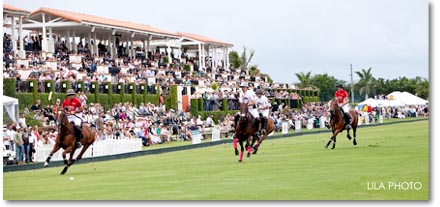
|
| A recent U.S. Open for polo was played in front of the main stadium - 50 yards from the croquet court. A "croquet box" is reserved for the eight players of the February Golf Croquet Invitational, at the height of the polo season. A high-profile pro-am doubles match has been arranged for noon on Wednesday preceding the main tournament, pairing two well-known polo stars with two Egyptian world champions of Golf Croquet. |
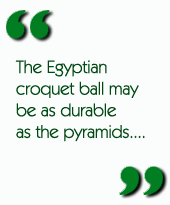 So it was essential for Egypt to develop and manufacture its own croquet ball, and the first generation was produced in the early 70's. Elhadary doesn't know if subsequent improvements of the ball were made after he left Egypt in 1995, but he recalls that the initial testing required a ball that did not chip or break when struck by a mallet or when hitting other balls or metallic hoops.
So it was essential for Egypt to develop and manufacture its own croquet ball, and the first generation was produced in the early 70's. Elhadary doesn't know if subsequent improvements of the ball were made after he left Egypt in 1995, but he recalls that the initial testing required a ball that did not chip or break when struck by a mallet or when hitting other balls or metallic hoops.
The most important test, Elhadary recalls, was the one on diameter, requiring that "the ball should pass the test of two 'no-go' gauges having between them the permissible allowance (1 32/nd inch) for at least the three dimensions."
What the players say
The ball is apparently composed of white material, with painted-on colors. The actual composition of the ball and the process by which it is made are unknown to me and assumed to be held as proprietary information in Egypt under patent law. The only source of the balls known to me is the president of the Egyptian Croquet Federation, who is accompanying his two world championship players to Palm Beach. If the balls are a smash hit (in a manner of speaking) in February 2011, perhaps we'll have more to report on their characteristics and move them closer to official approval for broader use in major events.
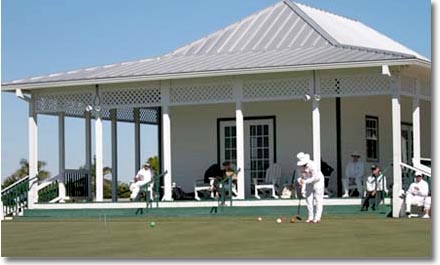
|
| The elevated wrap-around porch of the Sports House affords fine views of polo to the west, tennis to the north, and croquet to the south - and a measure of protection from air bourne balls. |
|
IS GOLF CROQUET A BETTER GAME WITH EGYPTIAN BALLS?
Back in the 70s when I started playing the game as a teenager, I remember seeing in the mallet room of Egypt's Zamalek Club many broken balls, ranging from chipped to reduced to halves. I actually played with balls that had lost some of their circumference. This was tricky because with every shot I had to place the ball on its intact circumference to ensure that it would go straight. At the time most of the ball damage resulted from hard impact with mallets and sometimes with hoops. Clearly, we needed balls strong enough to withstand the hard hitting of the Egyptian players. Some time in the 1980s, I remember that we were introduced to this new ball - heavier, stronger, and less brightly colored than the imported balls. These are the balls still used in Egypt, and for the International Polo event in February 2011. Let’s start with the physical characteristics of the Egyptian balls. Compared to the regular balls used outside of Egypt - mostly Sunshiny and Dawsons currently - they are a little smaller, slightly heavier, and smoother. Although their bounce against steel or concrete is similar to other balls, the ball-to-ball transfer of energy is spectacularly magnified. The hard hitting allows for great hoop clearances and impressive displacements even with a very thin cut of the target ball. If the target ball is hit in the dead center, the result is always a spectacular stop shot scarcely imaginable for a shot made with such strong force. In Zamalek Club, the term we used for that effect was “Technicolor” because the perfect stop-shot results in just a change of ball color as the striker ball replaces the target ball. The sound the Egyptian balls make when struck or when hitting another ball is unique. Players loved the crisp sound of the old Jaques Eclipse, and the Egyptian balls also make a great sound when struck. It's interesting to see people's reaction to this sound as we introduce these balls internationally. I compare it to the difference between hitting a major league baseball and hitting a soft ball. Some say that Egyptian balls feel and sound like billiard balls. When I moved from Egypt to the United States in 1991, playing with the Jaques, the Barlows and other types of softer balls felt to me like playing croquet with dead tennis balls. There is a need for standardization in croquet as in any sport. However, a sport still in a developing stage needs to allow and even encourage a certain degree of pragmatism and creativity. The Egyptian balls are definitely not suitable for Association or American croquet. They were never made for that purpose. They were not designed to produce predictably consistent croquet shots. Criteria need to be developed for a ball with the characteristics of the Egyptian ball which could be WCF approved for international competition. Is there any good reason why a ball could not be approved for one specific game - Golf Croquet - with no expectation that it will ever be used for Association Croquet? If top-level players prefer a ball with the characteristics of the Egyptian one, and if we can show that this ball makes a better game - for both players and spectators - that ball should be tested for approval for use in major competitions. - Mohammad Kamal |
